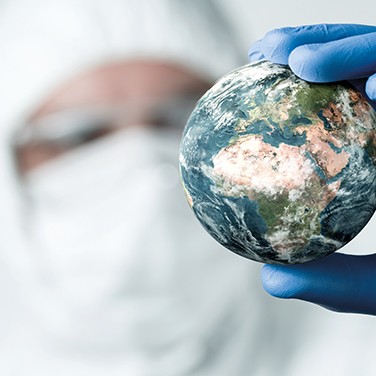Staying Agile During COVID-19: A Manufacturer's Perspective
As case numbers increased during the first three months of the COVID-19 pandemic, governments acted swiftly but focused on their own country’s best interests. Despite its start in late 2019, the pandemic’s global impact on supply chains was not fully appreciated until February 2020, when Chinese authorities declared workforce movement controls that halted manufacturing in China.
As the pandemic spread across the world, other producers of key raw materials and finished personal protective equipment (PPE) reacted similarly, severely impacting global supply. An unprecedented increase in demand and the simultaneous disruption of logistics and transportation only added to the situation.
While many countries advocated for local production of PPE, this was often not feasible in the short term. Manufacturing plant changes required additional time and money, and secondary suppliers of raw materials were also experiencing significant demands. As the pandemic progressed, governments began to consider long-term effects and started planning on more collaborative levels.
Successful Strategies and Lessons Learned
For Ansell, one successful strategy for supplying PPE during the pandemic was using numerous warehouses to quickly access local markets. However, this strategy requires significant product stock to absorb peaks in demand. This is not only expensive but also may be impractical for some products.
A second strategy was deploying manufacturing and production and diversifying sourcing. This increases the ability to manufacture PPE in multiple countries and to make the same product in multiple locations. Sourcing diversification provided options for acquiring key raw components to cope with disruptions in other parts of the supply chain.
While this ensures agility, there are difficulties with manufacturing a completely identical product using different suppliers, so consumers must accept small differences in product appearance and performance. This strategy may not work for products like surgical gloves, which are subject to medical device regulations that may restrict the use of alternate components.
A third strategy, process automation, has proven helpful in adjusting response plans to include manufacturing runs with fewer people and social distancing measures.
Overall, a combination of these strategies helped us successfully mitigate some of the issues during this pandemic. Along the way, more lessons will be learned and greater improvements made to ensure that we continue to protect supply chains in our industry.
Preparing for a Second Wave
In late April 2020, Dr. Anthony Fauci, director of the National Institute of Allergy and Infectious Diseases at the National Institutes of Health (NIH), was already talking about the inevitability of the virus’ return and how our handling would determine our fate.1 In spite of having successfully controlled the spread of the virus, Director Jung Eun-kyeong of South Korea’s Centers for Disease Control and Prevention reported that the second wave had already been detected in the country by late June of 2020.2
Countries, businesses, and hospitals have started to lift restrictions on elective surgeries. At the same time, some centers are stockpiling PPE in anticipation of a second wave of the virus. For some healthcare providers, this has increased concern that a second wave will create more pressure on the supply chain. Will Lange, chief of Honeywell’s PPE business, said the supply chain is not yet fully prepared for a second wave of significant PPE demand and that it will “probably take about nine months to get to a good spot.”3
Working Together
Unfortunately, stockpiled product is not necessarily available to frontline workers and the healthcare industry, where it is most needed. As governments and other industries become familiar with the importance of appropriate protection and the value of PPE, demand may exceed supply and drive prices up. Market imbalances may leave some developing countries struggling to procure enough PPE to protect their healthcare and frontline workers.
The coronavirus pandemic may have demonstrated the importance of an open, rules-based global trading program that requires nations to eliminate some trade barriers. In an open letter to the Australian British Chamber of Commerce, several trade ministers said this outbreak should “lead us to deepen our commitment to shared rules for the governance of global trade and investment.”4 No country is entirely self-sufficient in the supply of medicines, medical supplies, or PPE, and free-flowing trade plays a key role in crises like these.
As World Health Organization (WHO) Director General Tedros Adhanom Ghebreyesus recently said, “no organization and no country can fight this pandemic alone. Only by working together will we overcome this global threat. The greatest threat we face now is not the virus itself, it’s the lack of global solidarity and global leadership. We cannot defeat this pandemic with a divided world.”5
Extensively reshoring our essential capabilities can help minimize short-term supply risks for local business communities as economies stabilize. However, those taking advantage of the crisis should not be able to undo the decades of progress that the global community has accomplished. We need to continue to share the challenges and diversify our supply chains to become more resilient in the face of future shocks. Combating this global problem necessitates a global response, and we all have a part to play. It is not the first pandemic and it won’t be the last, but we hope to have learned how to be better prepared for and reduce the impact of future adverse events.
- Bloomberg Markets and Finance, Fauci Is Almost Certain Virus Will Return in Winter, Is Optimistic About a Vaccine https://www.youtube.com/watch?v=TSHobL-KESU Accessed 24 June 2020
- The Korea Herald, Second wave of coronavirus already here: KCDC chief http:// www.koreaherald.com/view.php?ud=20200622000240 Accessed 7 July 2020
- Digital Commerce 360, Grainger addresses a shortage of COVID-19 safety products https://www.digitalcommerce360.com/2020/06/19/grainger-andother-suppliers-address-shortage-of-safety-products/ Accessed 24 June 2020
- World Health Organization, World Government Summit https://www.who.int/dg/speeches/detail/world-government-summit Accessed 24 June 2020

